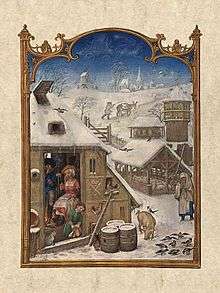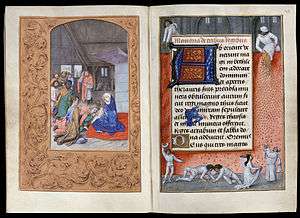Ghent-Bruges school
The Ghent-Bruges School is a manner or movement of manuscript illumination from about 1475 to about 1550 that developed in southern Netherlands, now Belgium. The term was first used in 1891 by Joseph Destree, author of Recherches sur les elumineurs flamands, and art historian Paul Durrieu.[1]

Flemish miniature (1510) with a realistic family at the foreground and a farmer and donkey going to the wind mill (at the back), (Breviarium Grimaldi - 1510).

Alexander Bening, Adoration of the Magi, before 1483, British Library
It replaced the "courtly style" of about 1440 to 1474 during the southern Netherlands reigns of Philip the Good and Charles the Bold. That mid-15th-century style consisted of works in primary colors of "wooden, clumsily painted stock figures".[1]
The Ghent-Bruges School style created illuminated manuscripts with realistic images of people, including half- and full-length portraits, colorful landscapes and the use of bright and pastel colors.[1]
Notable artists
- Alexander Bening
- Simon Bening
- Gerard Horenbout
- Lucas Horenbout
- Susanna Hornebolt
- Jan Provoost
- Levina Teerlinc
gollark: (for desktop applications)
gollark: There might be credentials stored in configs and stuff locally, I guess.
gollark: You should probably change them on high-priority stuff (email account) anyway, though.
gollark: I don't *think* so.
gollark: You also probably can't retroactively change the password the copies on the disks are encrypted with.
See also
References
- Jane Turner. The Grove Dictionary of Art: From Renaissance to Impressionism : styles and movements in western art 1400-1900. St. Martin's Press; 2000. ISBN 978-0-312-22975-7. p. 118.
This article is issued from Wikipedia. The text is licensed under Creative Commons - Attribution - Sharealike. Additional terms may apply for the media files.